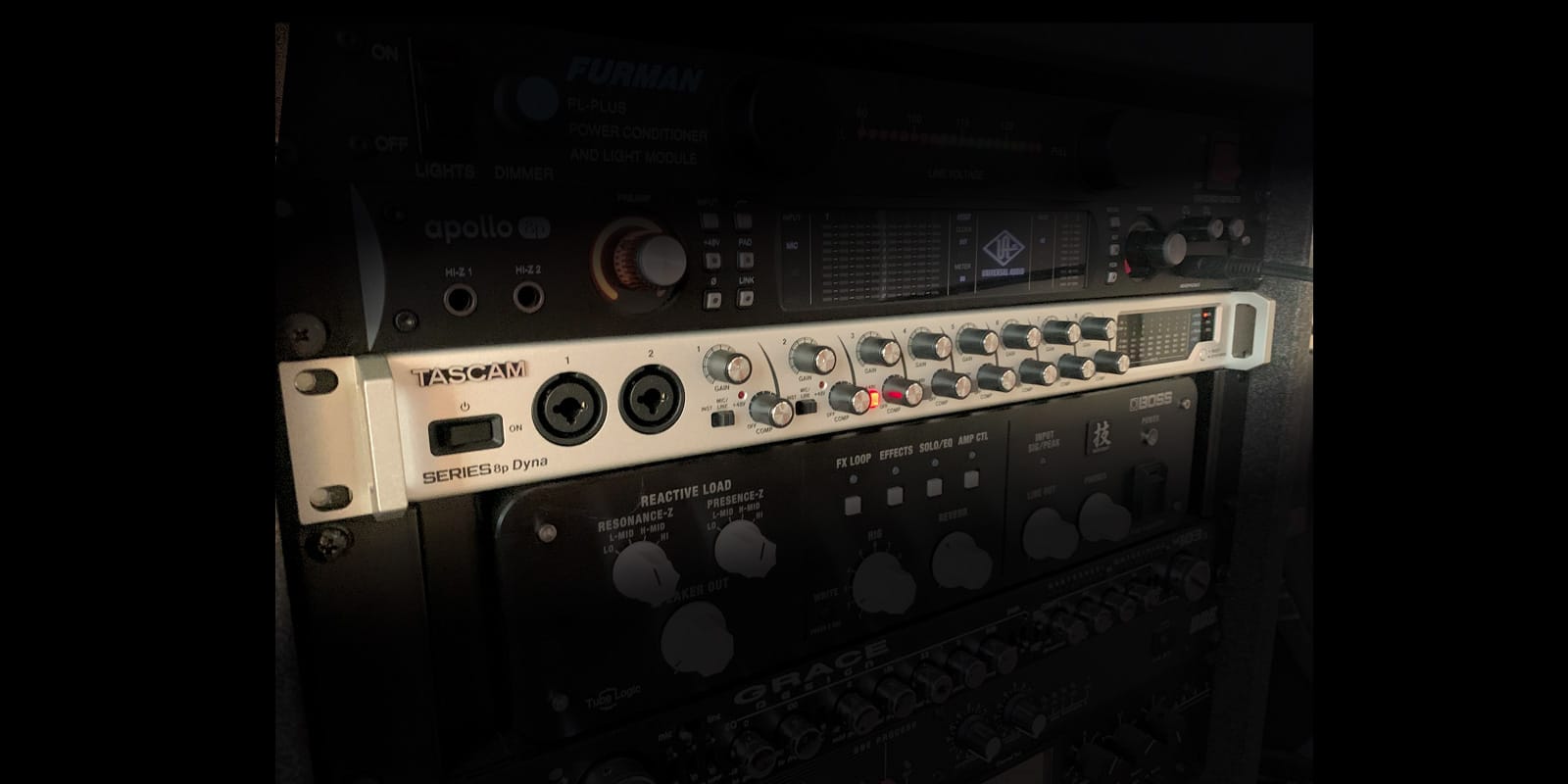A well-connected and affordable eight-channel microphone preamp with built-in compression
Review by Alex Hawley
The TASCAM SERIES 8p Dyna is a comprehensive eight-channel microphone preamplifier that features eight analog outputs via TRS or DB-25, dual S/MUX optical outputs, phantom power, word clock I/O, and simple analog compression on every channel. Its connectivity makes it an ideal candidate for growing studios that need to integrate more preamps; it expands TASCAM SERIES 102i, 208i and other S/MUX-compatible interfaces.
Overview
The TASCAM SERIES 8p Dyna is a 1U rackmount design with a clean-looking silver metal aesthetic. Across the front panel are two rows of eight knobs that control preamp gain and compression for every channel. The gain settings are marked with a shallow silver groove—a bit tricky to see against the silver knobs. The first two channels are DI-ready, with front-panel combo jacks and toggle switches that select instrument input, mic/line options, and phantom power. Channels 3-8 are accessed on the back panel and can all be phantom powered via front-panel switches. Rounding out the front is an LED metering panel—it’s cleanly organized and displays a lot of useful information: four-segment level meters (-42, -18, -6, and 0 dBFS), compression indicators (dimly lit while engaged; bright flashes when exceeding threshold values), overload indicators that light up 3dB prior to peaking, and sample rate information. Word clock I/O can be external, or set on the interface by press-holding the sample clock button to select formats up to 24/192.
Both ADAT ports can carry all eight outputs at 44.1 or 48 kHz , four outputs on each port at 88.2 or 96 kHz (S/MUX2), or four outputs across the two ports at 176.4 or 192 kHz (S/MUX4). The power supply is a barrel connection with a wall wart. This was a bit of a bummer for me, and I’m sure I’m not alone; these pesky wall warts steal adjacent spare outlets from power strips and power conditioners with standard-width outlet spacing (such as my Furman).
Past Featured Reviews
- Focal Solo6 Be 40th Anniversary Active Studio Monitors
- DECEMBER 2020: Warm Audio WA-87 R2 FET Condenser Microphone
- NOVEMBER 2020: IK Multimedia ARC System 3
- OCTOBER 2020: DPA 4006A and 4011A
- SEPTEMBER 2020: SPL Mercury Mastering DA Converter
- PreSonus Quantum 2626
- AUGUST 2020: Audix A150/A152 Headphones
- Gauge Precision Instruments ECM-80 Dynamic Vocal Microphone
- JULY 2020: TASCAM SERIES 8p Dyna
- JUNE 2020: oeksound soothe2 Dynamic Resonance Suppressor
- MAY 2020: Peluso P-28 Pencil Tube Condenser Microphone
- APRIL 2020: Sonible smart:comp
Preamps
The preamps in the SERIES 8p Dyna are HDIA (High Definition Instrumentation Architecture), which TASCAM touts as being its best design yet. They have a transparent sound with ultra-low noise. The specs confirm it all: EIN is listed at -127dBu, 0.0007% THD, with a dynamic range of 116dB and crosstalk of 119dB. The gain range is 52dB for the mic preamps, instrument inputs, and line inputs.
In terms of sound, I found the preamps to have a subtly bright and airy character, with a slightly forward upper midrange that sounds full of clarity and detail. After recording a variety of instruments through them, I found ribbon microphones to be an excellent pairing, especially on acoustic guitar, vocals, and grand piano. The detail of the upper midrange also felt right at home for spoken word and shined in voiceover sessions. It provides that polished, commercial sound without much effort. One issue I ran into: the lack of an integrated pad makes it a bit tricky for recording high-SPL instruments, especially with high-output condenser microphones. Even with the gain dialed all the way down, it was cutting it close in my tests with a 4×12 tube amp.
Compression
The compressors work at a fixed 3:1 ratio that feels like soft knee compression with fast attack and release (compressor ballistics are not described in the user guide); auto-makeup gain is tied to the threshold setting. The compressors’ single knobs adjust the threshold (30dB range), resulting in more compression when turning clockwise; full counter-clockwise turns engage true bypass.
This compression is useful for smoothing out peaks, but of course the shaping capability is limited. I found the one-knob design to provide a generous usable range, making it easy to set and forget. The process doesn’t impart any overtly colored character on the sound—it does its job well in taming unruly inputs and helping to avoid overload. It doesn’t appear to add any additional output, but it does a great job in keeping the output level consistent.
Final Thoughts
The TASCAM SERIES 8p Dyna provides an excellent value for those who need to expand on an existing system. The preamps are an excellent value, providing above-average signal-to-noise and clarity. They sound clean, transparent, and indeed have very low noise. While the lack of a pad is a drawback, having dynamics processing on every channel helps to stand in for any input sources that need a bit of taming. The only other nitpick I have, and this is indeed a nitpick, is that I have a tough time identifying where the knobs are set with only a subtle silver groove. A bit of black coloring on the groove would make for much less squinting when trying to establish levels—and while I didn’t test it in a live sound application, I can only imagine that this would be the case for anyone using the SERIES 8p Dyna at FOH as well.
Wrap Up
While there are some competitors in the field of eight-channel ADAT-equipped preamp units, TASCAM has an impressive offering with the SERIES 8p Dyna. If you’re in the market for additional preamps and have a TASCAM SERIES 102i or SERIES 208i interface, or any other variety of S/MUX compatible interface, I wouldn’t hesitate to add this one to your rack. The preamps sound great, the compression serves a very functional purpose, and it’s very well priced. What’s not to like here?
Price: $499
More from: tascam.com


